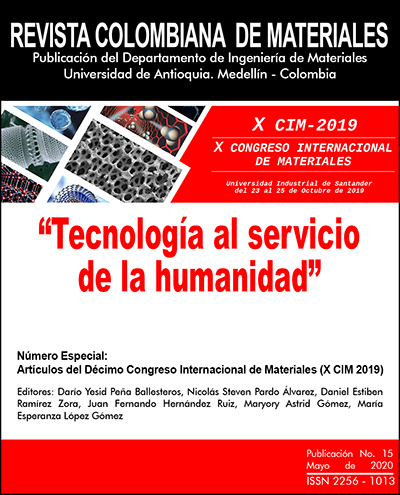Optimización de las condiciones de fabricación de cuerpos de prueba de tracción de una aleación Cu-8%Sn (AS-CAST) asistida con SOLIDCast®
DOI:
https://doi.org/10.17533/udea.rcm.342053Palabras clave:
propiedades mecánicas, simulación de fundición, impresión 3D, “as-cast”, líquidos penetrantesResumen
Un factor importante durante la medición de las propiedades mecánicas en tensión de materiales metálicos es obtener componentes de prueba fundidos con el mínimo de defectos. En este sentido es necesario mejorar las condiciones de fabricación de piezas fundidas para obtener mediciones con resultados confiables. En este trabajo se muestra la predicción de defectos y la optimización de parámetros de los modelos de fundición propuestos por la norma ASTM B208-14 mediante la simulación de la fundición para una aleación Cu-8%Sn utilizando SOLIDWorks® y SOLIDCast®. Los resultados de la optimización muestran que la temperatura, el tiempo de vaciado y turbulencia del metal líquido varían al ser comparados con los diseños propuestos. La temperatura del metal líquido es homogénea en el volumen de la pieza, siempre por encima de la temperatura de líquidos durante el llenado del molde. Las líneas de flujo evidencian una reducción en la turbulencia del metal líquido, disminuyendo la posibilidad de oxidación y atrapamiento de gases. Las simulaciones también mostraron que el alimentador compensó las contracciones y sus dimensiones permanecieron constantes, permitiendo la obtención de un mayor número de componentes metálicos. La placa modelo se fabricó por medio de impresión 3D obteniendo un modelo con alta resistencia mecánica y buen acabado superficial. El moldeo se realizó en arena de sílice aglomerada con resina fenólica, posteriormente se utilizaron líquidos penetrantes en la pieza fundida en estado “as-cast” para verificar la sanidad validando los resultados obtenidos en las simulaciones, evidenciando que el software predice la sanidad de piezas de fundición, ayudando a reducir tiempo de trabajo y costos.
Descargas
Citas
W. Reif and G. Weber, “A new grain refiner for copper-zinc alloys containing 25-42 percent zinc,” Metall, vol. 41, no. 11, pp. 1131–1137, 1987.
J. Marcelo, R. Arango, R. D. E. Grão, D. A. S. Ligas, D. O. Sistema, S. Paulo, J. Marcelo, and R. Arango, “Refino De Grão Das Ligas Do Sistema Cobre-Estanho,” 2016.
K. K. Sareen, Metal casting: Computer-aided Design and Analysis, 4th ed. Prentice-Hall India, 2007.
H. C. Pandit, A. Sata, V. V Mane, and U. A. Dabade, “Novel Webpublished in technical transactions of 60th Indian Foundry Congress, 2 4th March 2012.” Bangalore, pp. 535–544, 2012.
U. A. Dabade and R. C. Bhedasgaonkar, “Casting defect analysis using design of experiments (DoE) and computer aided casting simulation technique,” Procedia CIRP, vol. 7, pp. 616, 2013.
C. M. Choudhari, K. J. Padalkar, K. K. Dhumal, B. E. Narkhede, and S. K. Mahajan, “Defect free casting by using simulation software,” Appl. Mech. Mater., vol. 313, no. March 2013, 2013.
C. M. Choudhari, B. E. Narkhede, and S. K. Mahajan, “Casting Design and Simulation of Cover Plate Using AutoCAST-X Software for Defect Minimization with Experimental Validation,” Procedia Mater. Sci., vol. 6, no. Icmpc, pp. 786–797, 2014.
ASTM, “Standard Practice for Preparing Tension Test Specimens for Copper Alloy Sand , Permanent Mold , Centrifugal , and Continuous Castings 1,” Astm, vol. 96, no. Reapproved, pp. 1–9, 2015.
Descargas
Publicado
Cómo citar
Número
Sección
Licencia
Derechos de autor 2020 Revista Colombiana de Materiales

Esta obra está bajo una licencia internacional Creative Commons Atribución-NoComercial-CompartirIgual 4.0.








